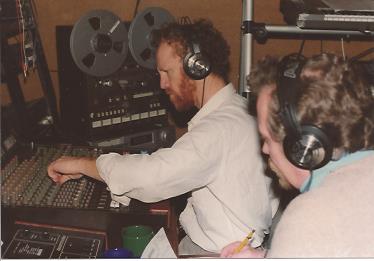New England theater-goers are familiar with the “pass the can” program in movie houses, produced by Travis's father's company, Pike Productions. In 1986, Lee Remick agreed to appear in the Jimmy Fund theatrical trailer, but her schedule did not allow her to fly to Boston, so Jim Pike called Travis to do the shoot in Hollywood. It was unpaid and Travis would have to supply his own crew, but all in a good cause. Travis was pleased to produce and direct, and especially proud of the way his Hollywood team responded. Cinematographer Peter Anderson supplied all the camera, grip and lighting equipment with Brian LeGrady volunteering as his camera assistant, Sound Mixer Dean Hodges supplied the sound gear, and Philip Moores acted as his boom operator. Vera Yurtchuk volunteered to provide Makeup and Hairdressing -- all of which enabled Lee Remick to do her bit for the Jimmy Fund quite literally in her own back yard. |
 |
In 1986, Travis' daughter Lisa graduated from UCLA with a Departmental Honors degree in Classical Civilization. She began working with Travis, learning all the film production computer programs and how to use them to format a screenplay, break it down, scout locations, get facility, service and equipment bids, schedule, and budget feature films, and they started prepping Morningstone. Of course, being a musical, the first thing they decided they needed was to update all the old Changeling music and record all the new music, to which end Travis convinced his friend, David Pinto, an extraordinary keyboard master, to arrange, perform and record a demo to introduce Morningstone to investors. |
With Lisa producing, David and Travis went to work in David's 8-track home studio, armed with Travis' acoustic guitar and David's state-of-the-art emulator keyboards and whatever else they needed to do the analog recordings. David and Travis had worked out a flat fee, and Travis paid for the 11-inch reels of 1/2 inch magnetic tape, paid the guest artists (mostly female vocalists), and they spent many long nights in the studio. Davids skills were more than up to the task, and the deal theyd struck proved to be a bargain for Travis, but with David playing 90% of the music, one track at a time, depending on the arrangement a single song might take two or more sessions to record. As for Travis, he almost never had to sing more than one song in a session, and could punch-in and overdub as many times as necessary to get the desired result. The sight-reading female vocalists David brought in were paid by the session, so theyd try to line up two or three songs per session, with David conducting and engineering. As for Lisa producing Travis' vocals, he would finish a song, and then Lisa would say if he should do it over, or punch in a section that wasnt up to her standard. Where others might have accepted Travis' close performances, Lisa pressed for his best at least, the best he had that night. Theyd begun recording in mid-1987 and in 1988, when they finally had the 8-track masters, Travis took them to his brother Adam's home studio, where they mixed, sweetened and mastered the demos. |
| BACK | HOME | NEXT |
|---|